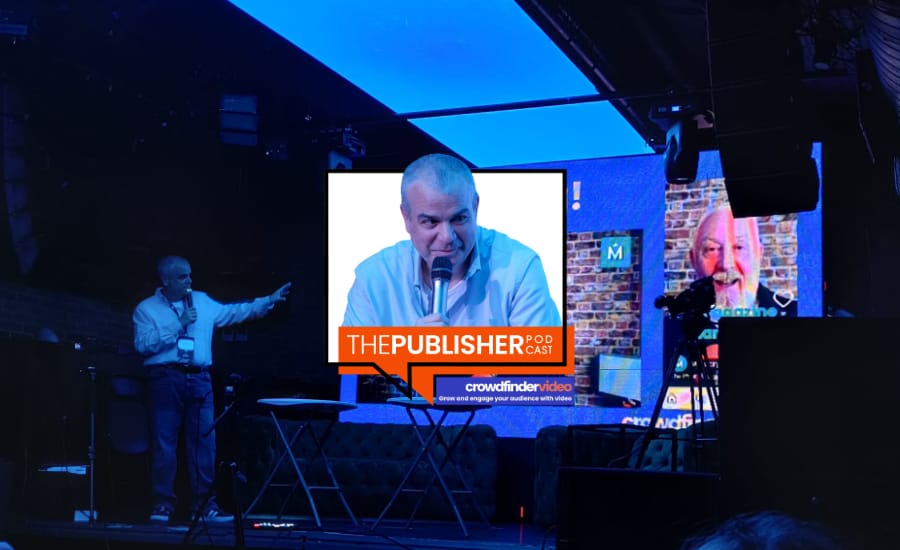- The Publisher Newsletter
- Posts
- What makes video work for magazine publishers?
What makes video work for magazine publishers?
From conceptualization to execution, Crowdfindervideo’s Simon Elliott shares his expertise on what makes video work for magazine publishers, providing valuable insights and practical tips for industry professionals.
Welcome to The Publisher Newsletter, by Media Voices: your weekly newsletter profiling the people and products powering publishing.
What makes video work for magazine publishers?
From conceptualization to execution, Crowdfindervideo’s Simon Elliott shares his expertise on what makes video work for magazine publishers, providing valuable insights and practical tips for industry professionals.
In this video podcast, recorded live at the Publisher Podcast Summit, Peter Houston and Simon Elliott discuss the significant benefits of video podcasting for publishers, emphasising its role in audience growth and revenue generation.
They explore the importance of building a structured video production process, the necessity of effective storytelling, and the challenges faced during the ‘pivot to video’.
Practical tips for starting a video podcast, editing content and enhancing viewer engagement are also shared, along with insights on how to present oneself confidently on camera.
Why video helps with growth
Video podcasts are never an end in themselves; they’re about bringing in revenue and growing your audience. What video podcasting gives you is a consistent supply of content you can use across multiple platforms: YouTube, Spotify, and social media clips.
I was talking to someone earlier who uses short cuts from her podcast on social media to grow her audience. It helps with discovery and awareness – being spotted at all, especially now that we’re in the era of zero-click searches.
Awareness and growth are where video really delivers. Social posts with video perform significantly better than those without – perhaps two or three times better. And video introduces people to your brand and the people behind it.
Publishers want to show audiences they’re authentic and real. In the AI era, people want to see real people, and video delivers that. Growth and discovery – through social media, newsletters, and embedded clips—are where video makes a difference.
How to get a ‘video machine’ up and running for publishers
I’ve worked in publishing – at Sky News and now at Al Jazeera – and those places are machines for producing content. Publishers need to build their own smaller machine for video. That means having the right people and the right technology.
It doesn’t have to be expensive, but it does require some investment if you want to deliver video regularly and consistently. Even one video a month with a few social edits can be enough, as long as it’s consistent.
Equip people properly. If you hire someone to handle video, get them the right software – something like Riverside – and a capable laptop. Expecting them to make videos on an old office machine just won’t work.
And give them time. If you hire someone relatively junior, that’s fine, but remember they might not have colleagues who understand video, so their learning curve will be slower.
Getting to the point
With video podcasts, you have to work harder at the start. People have less tolerance for slow intros.
If you’ve ever looked at a YouTube retention graph, they’re brutal – you can see viewers drop off almost immediately if you take too long to get to the point. You have to hook people early.
Most of the podcast doesn’t need to change, but that opening question or statement matters. For example, I might start with: “Your packaging matters more than your video.” That’s a hook; it makes people want to stay.
Simon’s 13.4 practical tips on making better video can be seen on vertical (for mobile) via Linkedin here. Or you can see Simon in his full, widescreen glory on YouTube here.
The fallout of the ‘pivot to video’
There’s definitely fear that history will repeat itself. I often hear, “We tried video; it didn’t work.” Respectfully, they tried bad video; slow, unengaging, and poorly presented.
The storytelling was good once you got into it, but the packaging wasn’t right – titles, thumbnails, hooks. And, to be honest, the “pivot to video” was really a pivot to Facebook. Facebook burned publishers, not video itself.
Now it’s about making video for your audience, not for a platform.
Video podcasts give you both discovery and engagement. Social clips drive awareness and attract new audiences; the full podcast keeps people spending real time with your brand.
Starting out in video for those who haven’t done it before
Start with camera confidence. A lot of people in publishing don’t want to be on camera, and I get that. But if you love your brand, it’s important to represent it. Editors represent their magazines at events—it’s no different on video.
Technically, start with something like Riverside. It’s basically a fancy Teams call. Practice, frame yourself properly, and just start. You don’t have to publish the first recording—treat it as a trial run.
Don’t overthink it. You’re not making a Marvel movie. Just make sure it’s in focus, framed well, and “good enough.”
This video podcast episode was produced in partnership with Crowdfindervideo.
You want the audience growth and engagement that come with video and audio but don’t have the hours in the day? Crowdfindervideo clients make the decisions on their content but we do the production work. We deliver the audio, video and social assets that turn your ideas into a consistent, multi-platform presence. We’ll also do the thumbnails and show notes. We can even upload for clients.

